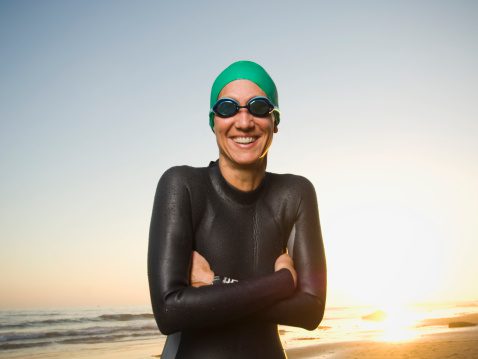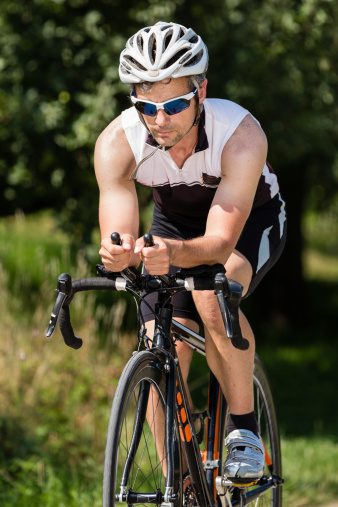Your First Sprint Triathlon

— By LifeSport coach Dan Smith
As the most popular triathlon, the Hawaii Ironman World Championship is often the first exposure athletes have to the sport, making a lasting impression and coveted aim for many. However, the training and preparation required just to make it to the start line for an Ironman distance race are extensive. The good news is that there are many shorter events that offer beginner tri- athletes a great place to start.
Beginners should look no further than the sprint triathlon. While there is a standard length for sprint triathlons (750 m swim, 20 km bike and 5 km run) many race directors will call shorter races a “Sprint.” These shorter races will typically consist of a 500 to 750 m swim, 20 to 25 km bike and a 3 to 6 km run. They are held by themselves or are staged in conjunction with the longer distance races. To encourage participation, many early season races will begin indoors with a pool swim.
The wonderful thing about a sprint distance is that anyone with minimal athletic background can complete it with four to six weeks of preparation, pro- viding one can initially swim 50 m, ride a bike around the block, and walk a few 100 m. In addition to the swim, bike, run, the transition is considered triath- lon’s fourth discipline and must not be neglected. The shorter the event, the faster the transition should be.
As sprint triathlons are beginner-friendly, you can enter with whatever equipment you have on hand – no need to go out and purchase fancy gear. The basic requirements are a bathing suit and pair of goggles for the swim; either a road bike with toe clips, a hybrid/ commuter, or a mountain bike with slick tires and a pair of running shoes.
Swim
Following the six-week plan below will give you the ability to swim a sprint distance comfortably. It provides a gradual weekly increase of swim distances to build endurance and confidence. Before your race, joining an open water swim group is one of the best ways to practice getting comfortable with swimming in close proximity to others and learning how to sight in order to swim in a straight and direct line.
Bike
This is the longest part of the triathlon, both in time required and distance covered. Gradually build your endurance on the bike, if you come from a cycling background you may want to spend more time on your weaker disciplines. Tri-specific shorts will make your saddle more comfortable, and because you can swim in them, they make your transition quicker. Pre-riding the race course provides an opportunity to preview the terrain and learn where the hills and tricky corners are. The effort should be spread out over the entire ride rather than relying on short bursts. While doing this, mentally break the course into 10-minute sections. Once the section is completed, move on to the next one. Keep the effort even on the flats and the hills, shifting gears where necessary. The final kilometre of the bike should be a slightly higher cadence to prepare for the run and give your legs a bit of a break. Be aware of the dismount line where you must come to a full stop, get off your bike and run it into the transition area. Your helmet must remain securely fastened until your bike is racked.
Run
The run is challenging because it follows the swim and bike and your legs are fatigued by that point. A high cadence is as important while running as cycling. Focus on running tall with a relaxed upper body, gaze directed down the road. Keep in mind that during the lead up to the race you should run the entire distance a few times. If you feel particularly motivated, running a 5 km road race beforehand will give you confidence. Building effort through the run will help you finish strong.
Transitions
Spend some time getting used to the changeover between the different disciplines. Transitions don’t need to be rushed, keep the movement steady and purposeful, that way you don’t get confused or caught up in an incident – like getting all the way to the mount line only to be stopped because you forgot your helmet.
Going from horizontal in a sensory deprived environment (water) to hurtling down the road can be quite a shock. When coming out of the water, the body is somewhat unresponsive and there is a sense of disorientation which is normal. Use the time running from the water to the bike to get the blood flowing to the brain again and mentally rehearse what you will do when you get to the bike. You will need to put your helmet on and fasten it, then put your shoes on and then move quickly with your bike to the mount line. On the bike, focus on spending the first 5 to 10 minutes getting the legs turning smoothly. Once they are less heavy, get into a steady rhythm of pedalling, aiming for a cadence of between 85 and 95 rpm. Similarly, use the first kilometre of the run to think about cadence. Give yourself reminders such as quick feet, quick arms to keep yourself moving well. Usually, the further you run the better the body will feel.
Race Day
Give yourself plenty of time to get to the race site, leaving yourself an hour after checking in. All racers will have to get body marked, pick up a timing chip and swim cap, rack their bikes and lay out their transition areas with helmet and shoes. Take note of where your spot is on the rack. Laying your gear on a brightly coloured towel can help you locate your bike after the swim.
The most important thing on race day, no matter the race, is to warm up properly. The shorter the race, the longer the warm-up necessary. Use this time to activate the body, get the blood flowing and put the mind in race mode. No matter how strong a swimmer you are, spend 10 to 15 minutes in the water completing a structured warm up before the start. A good warm up consists of 8 to 10 min mixed strokes easy, followed by some activation – 4 x (20 strokes vigorous, 20 strokes easy). When the water is cold this is doubly important and can help prevent disorientation, hyperventilation and anxiety.
Settle into a rhythm once the gun goes off, aim to put out a consistent effort, knowing that you have trained well to complete the triathlon. Remember to keep the focus short, break each discipline down into small pieces, checking them off as you complete each one.
And, as always, have fun.

